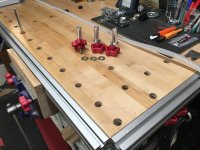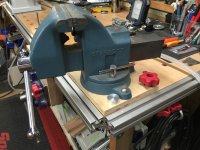I'm building a table for my ammo reloading equipment. I'm going to put 20 mm holes in the top so I can use the festool clamps on the table. I will also use "some" of these 20 mm holes to screw my equipment to. I'm looking for threaded inserts that will install into the 20 mm holes, so I can screw my equipment to the table, any ideas where I can get threaded inserts for a 20 MM hole. The threaded inserts will need to be approximately .5944 - .7976 mm larger than the 20 mm hole. Any ideas?
The top I'm fastening these to is 1.75" think. It's one of those butcher block type of table tops.
Thanks in advance
The top I'm fastening these to is 1.75" think. It's one of those butcher block type of table tops.
Thanks in advance


